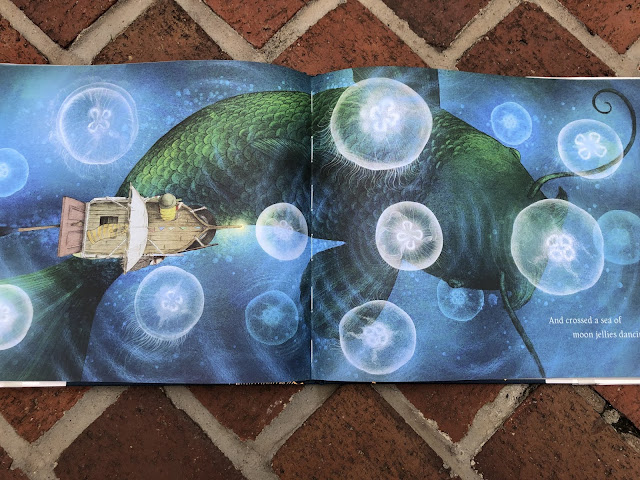DADS READ: “Ocean Meets Sky” by the Fan Brothers; reflections on light, refraction, and perceptions of reality
JER: “Ocean Meets Sky” by the Fan Brothers (Terry Fan and Eric Fan) represents to me the persistence of memory, the mystical, and our connection to our ancestors.
Mirage, in optics, the deceptive appearance of a distant object or objects caused by the bending of light rays (refraction) in layers of air of varying density.
Under certain conditions, such as over a stretch of pavement or desert air heated by intense sunshine, the air rapidly cools with elevation and therefore increases in density and refractive power. Sunlight reflected downward from the upper portion of an object—for example, the top of a camel in the desert—will be directed through the cool air in the normal way. Although the light would not be seen ordinarily because of the angle, it curves upward after it enters the rarefied hot air near the ground, thus being refracted to the observer’s eye as though it originated below the heated surface. A direct image of the camel is seen also because some of the reflected rays enter the eye in a straight line without being refracted. The double image seems to be that of the camel and its upside-down reflection in water. When the sky is the object of the mirage, the land is mistaken for a lake or sheet of water.
As I thought about what a "mirage" is, it made me question "objective reality". How do I know I am seeing the "real thing", and not the bent refracted image of an object/reality that isn't where I perceive it to be? "Ocean" appears to meet "sky" because the light from the sky gets refracted over the water and the image of the "sky" gets refracted towards our eyes, the "ocean" and "sky" seem to hover over each other. The sunset we "see" with our eyes is actually the position of the sun when it is already below the horizon, since the light is getting bent through the atmosphere, that is why the sun appears more "red" at sunset.
The atmosphere is acting like a prism.
With the least scattered wavelength, e.g. red, being the last we see as the Sun is setting.
For a more detailed explanation about light refraction, the sky, and sunsets, see this excellent write-up by Philip Gibbs, May 1997, "Why is the sky blue?"
While reading "Ocean Meets Sky", I also really appreciated the focus on ancestors, as I feel very close to those who have gone before me. That is partly why we relied on our respective genealogies for our girls’ names. Our oldest, Lake Marie, has Mallory’s last name (Lake) and the middle name of Mallory's mother (Marie). Our youngest, Ejler Rae, has my paternal grandparent’s first name (Ejler) and my maternal great-grandparent’s amalgamated name (Anna Rebecca - "Rae").
In this story, Finn finds himself reflecting back on his grandfather on his birthday. He prepares for “a long journey. One they had planned together”. Finn appears to have taken the journey alone, but he finds guides along the way, like a “great golden fish” and the “moon” - both of whom resemble his grandfather.
My oldest sister passed away 11 years ago, but I often feel her presence and energy here among us. I really like this book because it plays with this concept of engaging with our ancestors and keeping their memories alive. I try to do that with my sister. I look for her in passing animals and in the sky.









Comments
Post a Comment